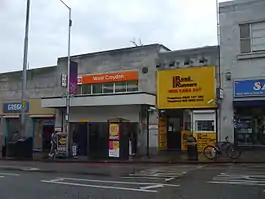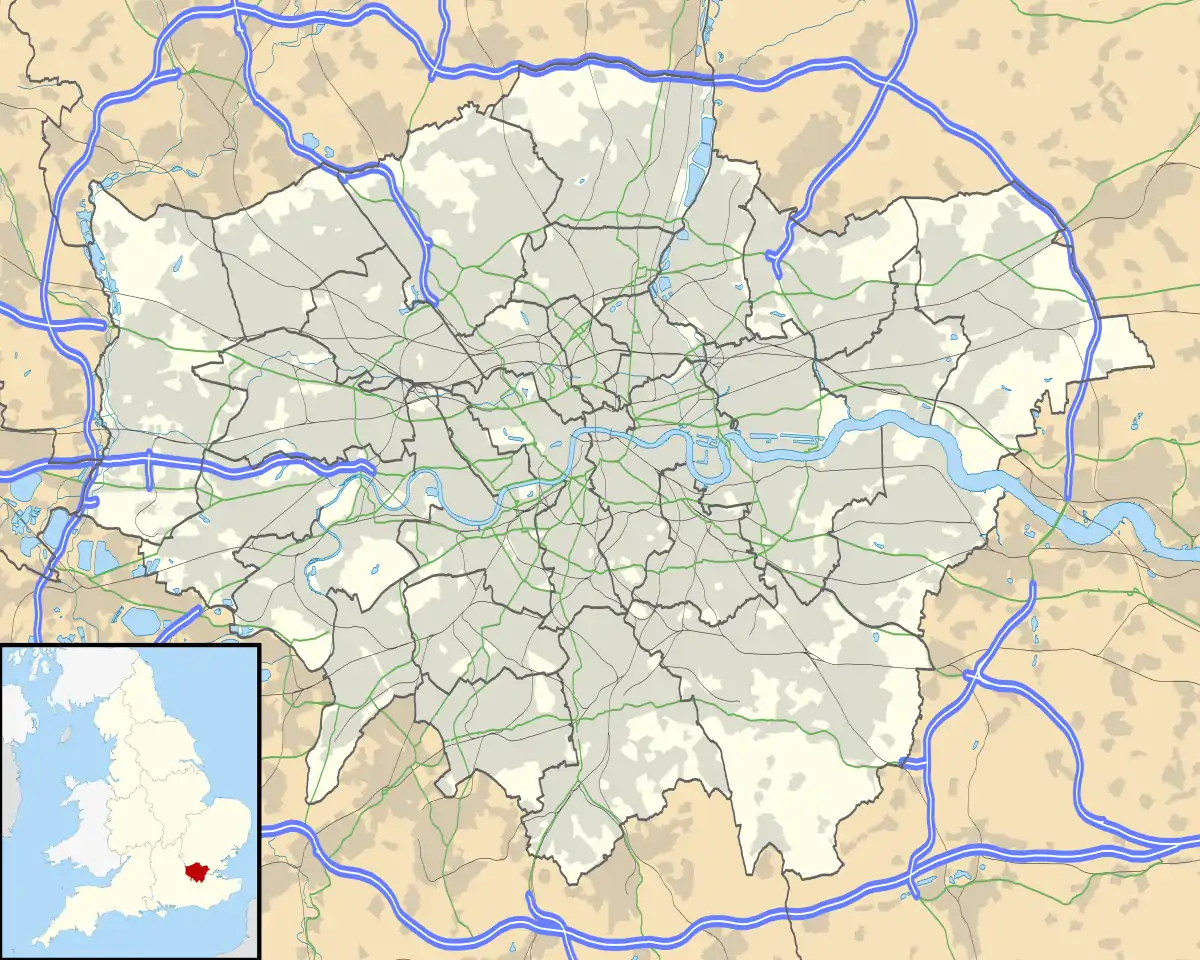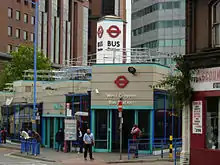West Croydon station
West Croydon is a combined railway, bus station and tram stop in Croydon, south London. It is served by National Rail, London Overground, Tramlink and London Buses services and is in Travelcard Zone 5.
| West Croydon | |
|---|---|
 | |
 West Croydon Location of West Croydon in Greater London | |
| Location | Croydon |
| Local authority | London Borough of Croydon |
| Managed by | London Overground |
| Owner | Network Rail |
| Station code | WCY |
| DfT category | C2 |
| Number of platforms | 3 (formerly 4) |
| Accessible | Yes[1] |
| Fare zone | 5 |
| Tramlink annual boardings and alightings | |
| 2009–10 | 1.312 million[2] |
| 2010–11 | 1.502 million[3] |
| National Rail annual entry and exit | |
| 2015–16 | |
| – interchange | |
| 2016–17 | |
| – interchange | |
| 2017–18 | |
| – interchange | |
| 2018–19 | |
| – interchange | |
| 2019–20 | |
| – interchange | |
| Railway companies | |
| Original company | London and Croydon Railway |
| Pre-grouping | London Brighton and South Coast Railway |
| Post-grouping | Southern Railway |
| Key dates | |
| 5 June 1839 | Opened as Croydon |
| April 1851[5][6] | Renamed West Croydon |
| Other information | |
| External links | |
| WGS84 | 51.3782611°N 0.1025444°W |
The East London line, part of London Overground, was extended to the station in 2010. On the National Rail network it is 10 miles 35 chains (16.80 km) measured from London Bridge.
Facilities
Railway station

The main entrance is on London Road, a short distance from the main shopping area. There are ticket barriers protecting the platforms. Trains run to London Victoria, London Bridge, Highbury & Islington, and Sutton and from there to west Surrey and West Sussex.
By December 2009 station remodelling and tracklaying were completed for the southern extension of the East London Line, of which West Croydon is a terminus. The space occupied by former bay platform 2, out of use since the Wimbledon service was withdrawn in 1997 and replaced by Tramlink in 2000, has been utilised to extend platform 3, the London-bound platform. Bay platform 1 has been retained. There is no Platform 2.
In April 2012 a new entrance was constructed in Station Road, allowing direct access to the railway station from the adjacent bus and tram stops.[7]
Bus station and tram stop



A short distance from the main entrance is Station Road, where West Croydon bus station and tram stop are located. The tram stop is next to, but was for a long time physically separate from, the rail platforms, until the construction of the new entrance. All Tramlink routes use West Croydon, which is a single platform stop on the unidirectional loop around central Croydon.
The bus station is a hub for London Buses, with 25 bus routes terminating or passing through. A new bus station opened in 2016.[8]
History

From 1809 to 1836 the site was the terminal basin of the Croydon Canal. The canal was drained and became part of the route of the London & Croydon Railway, opening on 5 June 1839.[5] In 1845 the L&C inaugurated the atmospheric system of propulsion; it worked for about a year but was not successful.[5] On 23 September 1846, a fire broke out in a lamp room, severely damaging the station and destroying thirteen carriages. Damage was estimated at £10,000.[9] The station was originally named Croydon; in April 1851 it became West Croydon.[5]
The canal basin was served by a short private branch from the terminus of the Surrey Iron Railway (SIR) at Pitlake. From 1855 the station was the terminus of the West Croydon to Wimbledon Line, which followed much of the route of the SIR. This line closed on 31 May 1997, to be replaced by Tramlink. Platform 2, the terminal bay for the Wimbledon line, was trackless until 2008. Very little remains of this platform apart from a little section at the western end, as most of it was filled in to extend platform 3 to allow trains to stop closer to the stairs.
In 1912 the composer Samuel Coleridge-Taylor (1875–1912), who was a resident of Croydon, collapsed whilst on the station. This was due to overwork and pneumonia. He died at home a few days later.
During the 1930s the station saw major alterations and reconstruction. A new ticket office was built on London Road. The original station buildings, ticket office and entrance in Station Road were closed and are still standing, converted to a shop.
Services
Trains are provided by Southern and London Overground. West Croydon is Croydon's second station, used mainly by suburban trains: the main station is East Croydon, served by express trains to London and the South Coast and suburban trains.
The typical off-peak service (Monday to Saturday) from the station is:[10]
- 2tph (trains per hour) to London Bridge - semi-fast
- 6tph to London Victoria:
- 4tph via Streatham Common and Balham
- 2tph via Crystal Palace and Balham
- 4tph to Highbury & Islington via New Cross Gate and Dalston Junction
- 6tph to Sutton
- 2tph to Epsom Downs
- 2tph to Epsom
At peak hours, there are direct trains to Guildford, Dorking, and London Bridge via Streatham, Dulwich, and Peckham Rye.
| Preceding station | Following station | |||
|---|---|---|---|---|
| Selhurst | Southern Sutton & Mole Valley Line |
Waddon | ||
| Norwood Junction | Southern Sutton & Mole Valley Lines London Victoria to West Croydon Via Crystal Palace London Bridge to Epsom via Wallington |
|||
| Norwood Junction | Southern London Bridge to Sutton via Forest Hill stopper Peak hour only |
Wallington | ||
| Preceding station | Following station | |||
towards Highbury & Islington | East London Line | Terminus | ||
| Preceding tram stop | Following tram stop | |||
One-way operation | Tramlink Wimbledon to Beckenham Junction | towards Beckenham Junction |
||
| Tramlink Wimbledon to Elmers End | towards Elmers End |
|||
| Tramlink New Addington to Croydon town centre | towards New Addington |
|||
| Disused railways | ||||
| Waddon Marsh | Connex South Central West Croydon to Wimbledon Line |
Terminus | ||
References
- "Network Map". Southern Railway. Retrieved 2 January 2010.
- "Tram Stop Usage 2009-10 (FOI)" (XLS). Tramlink annual passenger performance 2009-2010. Transport for London. 18 August 2011. Retrieved 28 November 2012.
- "Tramlink numbers 2010-2011" (PDF). Tramlink annual passenger performance 2010-2011. Transport for London. 28 March 2012. Retrieved 28 November 2012.
- "Station usage estimates". Rail statistics. Office of Rail Regulation. Please note: Some methodology may vary year on year.
- Butt, RVJ (1995). The Directory of Railway Stations. Yeovil: Patrick Stephens. pp. 73, 245. ISBN 1-85260-508-1. R508.
- Forgotten Stations of Greater London by J.E.Connor and B.Halford
- "New entrance to West Croydon station provides better access for all". Transport for London. 5 April 2012. Retrieved 27 June 2012.
- ""Milestone" bus station opens as part of West Croydon's multimillion pound redevelopment". Your Croydon. Croydon Council. 14 October 2016.
- "Serious Fire at the Croydon Terminus". Hampshire Advertiser and Salisbury Guardian (1207). Southampton. 26 September 1846. p. 3.
- electronic National Rail Timetable (eNRT) (Timetable Nos.171, 172, 177, and 178 May 2018) Network Rail
External links
| Wikimedia Commons has media related to West Croydon station. |
- West Croydon tram stop The Trams
- East London Line extension Transport for London
- Train times and station information for West Croydon station from National Rail